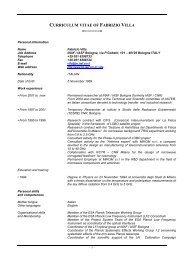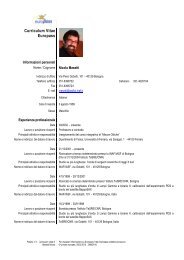Agatha Christie's Poirot Episode Guide - inaf iasf bologna
Agatha Christie's Poirot Episode Guide - inaf iasf bologna
Agatha Christie's Poirot Episode Guide - inaf iasf bologna
Create successful ePaper yourself
Turn your PDF publications into a flip-book with our unique Google optimized e-Paper software.
<strong>Agatha</strong> Christie’s <strong>Poirot</strong> <strong>Episode</strong> <strong>Guide</strong><br />
recently. While she is visiting, an art critic called Alexander Guthrie arrives to look through Cora’s<br />
recent purchases, but there is nothing of any value there. Immediately afterwards, Miss Gilchrist<br />
is nearly killed by arsenic poison in a slice of wedding cake that has been apparently sent to her<br />
through the post. The only reason that she is not killed is that, following a superstition, she has<br />
saved the greater part of the slice of cake under her pillow.<br />
<strong>Poirot</strong> focuses on the Abernethie family, and a number of red herrings come to light. Rosamund<br />
Shane, one of the heiresses, is an inflexible and determined woman who seems to have something<br />
to hide (which turns out to be her husband’s infidelity and her own pregnancy). Susan’s<br />
husband, Gregory, is a dispensing chemist who had apparently been responsible for deliberately<br />
administering an overdose to an awkward customer. He even confesses to the murder of Richard<br />
Abenerthie near the close of the novel, but is discovered to have a pathological compulsion to<br />
be punished for crimes of which he is innocent. Timothy Abernethie, an unpleasant invalid who<br />
seems to be feigning illness in order to gain attention, might have been able to commit the murder<br />
of Cora, as might his suspiciously strong-armed wife, Maude. Perhaps identifying the murderer<br />
may depend on finding a nun whom Miss Gilchrist claims to have noticed... But what can all this<br />
have to do with a bouquet of wax flowers to which <strong>Poirot</strong> pays attention?<br />
After playing games in mirrors, Helen Abernethie telephones Entwhistle with the news that<br />
she has realized something about the murderer. Before she can say what it is she is savagely<br />
struck on the head.<br />
<strong>Poirot</strong>’s explanation in the denouement is a startling one. Cora had never come to the funeral<br />
at all; it was Miss Gilchrist, who disguised herself as Cora in order to plant the idea that Richard’s<br />
death had been murder. Therefore when Cora herself was murdered, it would seem that the alleged<br />
murderer had struck again. Since no one had seen Cora for many years, and Miss Gilchrist<br />
had been able to copy many of her mannerisms, it was unlikely that the ruse would be spotted,<br />
except for the fact that she had rehearsed a characteristic turn of the head in a mirror, where the<br />
reflection is reversed. When she came to do it at the funeral, she turned her head to the wrong<br />
side. Helen had had the feeling that something was wrong when Cora had made her statement,<br />
but not realized at the time that it was this incorrectly reproduced gesture. Miss Gilchrist had<br />
further given herself away by referring to the wax flowers; these were present on the day of the<br />
reading of the will but had been put away by the time Miss Gilchrist (as herself) met the family.<br />
She had deliberately poisoned herself with the arsenic-laced wedding cake to avoid suspicion;<br />
ironically this only aroused <strong>Poirot</strong>’s misgivings.<br />
The ’murder’ of Richard needed to be established so that Miss Gilchrist’s own motive for killing<br />
Cora would be obfuscated when she killed her. Miss Gilchrist desperately wanted a painting that<br />
Cora had bought at a sale and which she had recognized as a Vermeer, but Cora had no idea just<br />
how valuable the artwork was. Miss Gilchrist loathed Cora and was plotting to sell the Vermeer<br />
in order to escape her dreary life and rebuild her beloved teashop, which she had lost during the<br />
war. Miss Gilchrist had subsequently hidden the Vermeer behind her own painting depicting the<br />
destroyed pier copied from the postcard in order to disguise the painting amongst others left to<br />
her in Cora’s will.<br />
At the end of the novel, Miss Gilchrist is understandably found to be completely insane. She<br />
was arrested and later put in a sanitarium.<br />
150

















